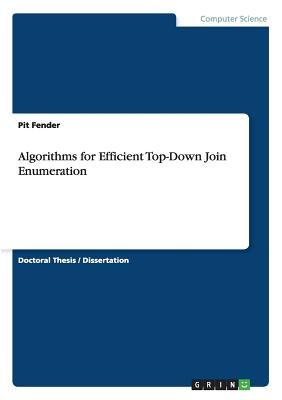
- We will send in 10–14 business days.
- Author: Pit Fender
- Publisher: GRIN Verlag
- Year: 2014
- Pages: 208
- ISBN-10: 3656663424
- ISBN-13: 9783656663423
- Format: 14.8 x 21 x 1.2 cm, softcover
- Language: English
- SAVE -10% with code: EXTRA
Reviews
Description
Doctoral Thesis / Dissertation from the year 2014 in the subject Computer Science - Applied, grade: summa cum laude, University of Mannheim (School of Business Informatics and Mathematics), course: Databases, language: English, abstract: For a DBMS that provides support for a declarative query language like SQL, the query optimizer is a crucial piece of software. The declarative nature of a query allows it to be translated into many equivalent evaluation plans. The process of choosing a suitable plan from all alternatives is known as query optimization. The basis of this choice are a cost model and statistics over the data. Essential for the costs of a plan is the execution order of join operations in its operator tree, since the runtime of plans with different join orders can vary by several orders of magnitude. An exhaustive search for an optimal solution over all possible operator trees is computationally infeasible. To decrease complexity, the search space must be restricted. Therefore, a well-accepted heuristic is applied: All possible bushy join trees are considered, while cross products are excluded from the search. There are two efficient approaches to identify the best plan: bottom-up and top-down join enumeration. But only the top-down approach allows for branch-and-bound pruning, which can improve compile time by several orders of magnitude, while still preserving optimality. Hence, this thesis focuses on the top-down join enumeration. In the first part, we present two efficient graph-partitioning algorithms suitable for top-down join enumeration. However, as we will see, there are two severe limitations: The proposed algorithms can handle only (1) simple (binary) join predicates and (2) inner joins. Therefore, the second part adopts one of the proposed partitioning strategies to overcome those limitations. Furthermore, we propose a more generic partitioning framework that enables every graph-partitioning algorithm to handle join predicates involving more
EXTRA 10 % discount with code: EXTRA
The promotion ends in 18d.20:11:14
The discount code is valid when purchasing from 10 €. Discounts do not stack.
- Author: Pit Fender
- Publisher: GRIN Verlag
- Year: 2014
- Pages: 208
- ISBN-10: 3656663424
- ISBN-13: 9783656663423
- Format: 14.8 x 21 x 1.2 cm, softcover
- Language: English English
Doctoral Thesis / Dissertation from the year 2014 in the subject Computer Science - Applied, grade: summa cum laude, University of Mannheim (School of Business Informatics and Mathematics), course: Databases, language: English, abstract: For a DBMS that provides support for a declarative query language like SQL, the query optimizer is a crucial piece of software. The declarative nature of a query allows it to be translated into many equivalent evaluation plans. The process of choosing a suitable plan from all alternatives is known as query optimization. The basis of this choice are a cost model and statistics over the data. Essential for the costs of a plan is the execution order of join operations in its operator tree, since the runtime of plans with different join orders can vary by several orders of magnitude. An exhaustive search for an optimal solution over all possible operator trees is computationally infeasible. To decrease complexity, the search space must be restricted. Therefore, a well-accepted heuristic is applied: All possible bushy join trees are considered, while cross products are excluded from the search. There are two efficient approaches to identify the best plan: bottom-up and top-down join enumeration. But only the top-down approach allows for branch-and-bound pruning, which can improve compile time by several orders of magnitude, while still preserving optimality. Hence, this thesis focuses on the top-down join enumeration. In the first part, we present two efficient graph-partitioning algorithms suitable for top-down join enumeration. However, as we will see, there are two severe limitations: The proposed algorithms can handle only (1) simple (binary) join predicates and (2) inner joins. Therefore, the second part adopts one of the proposed partitioning strategies to overcome those limitations. Furthermore, we propose a more generic partitioning framework that enables every graph-partitioning algorithm to handle join predicates involving more


Reviews